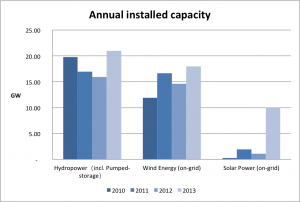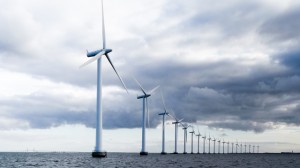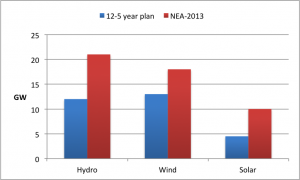See how renewable energy has developed in China since 2005.
[infogram id=”china-re-power-development-2005-2017-1h0n25ddy0x96pe”]
Category Archives: Hydro power
Danmark 2012: 30% wind power and no curtailment at all – how is it possible?
2012 was a new record year for wind power in Denmark. Last year the wind power production in Denmark amounted to 30% of the Danish electricity consumption, while in 2011 the figure was 28,2%. This is of course good news for the global environment but due to Denmark’s small size the biggest contribution to the global environment might not be the CO2 reduction itself but the Danish showcase: It is possible to have a high share of fluctuating electricity production in the energy system without curtailment at all. And 30% is only a step towards the even more ambitious target of 50% in 2020. Right now the next off-shore wind farm is being established in Denmark – see the pictures here. (The picture below is the Danish wind farm Middelgrunden near Copenhagen on a cloudy October day in 2012).
But what is the secret behind the large share of wind power, and what can China learn from Denmark?
A number of factors enables the high wind power penetration. Denmark has strong transmission lines to the neighbouring countries and access to hydro power storage in Norway. And a well functioning electricity market ensures optimal use of these interconnectors and the optimal combination of wind power and hydro power. The dynamic pricing of electricity created by the electricity market send price signals hour by hour to the producers and consumers. When the electricity production is high due to wind power and combined heat and power production (CHP), the electricity price is low; and when the wind power production is low (or zero) the price gets higher. This system also gives strong incentives for the power producers to make their thermal power plants more flexible. In facts, some of the coal fired power plants in Denmark can produce electricity and heat at a level of 10% of their maximum capacity. In China the requirements for minimum production is 50% of the max. capacity for the coal-fired power plants. All Danish CHP plants have also heat storage attached, which makes it easier to decouple heat and power production. When the electricity price is high, the CHP plants produces electricity and surplus heat can be stored in the heat storage, which basically is a large water tank. When the electricity price is low, the heat consumption is covered by the heat storage alone. And when the electricity price is very low, it can be beneficial to use electricity to warm up the water in the heat storage instead of running the thermal CHP plant. The combination of wind power, hydro power and thermal CHP plants with heat storage gives a very flexible system which is the physical explanation behind the high RE share in the Danish electricity supply.
To fully understand the Danish success of integrating wind power, you should also take into account the institutional and the “mental” framework for the electricity supply sector. In many countries – also in China – wind power is often regarded as an “add-on” to the “normal” electricity supply based on thermal power plants – fossil fuel or nuclear. The add-on RE power then is supposed to take care of its own problems, e.g. balancing the fluctuating production, and if it is not possible, then the easy solution is to curtail it, e.g. to stop the production from the wind farms, because the wind farm is causing the problem. But in Denmark, wind power is regarding as an integrated part of the electricity supply. Balancing problems is therefore a system problem, not a problem for the wind farms. This mental change in the perception of the electricity system is important for solving the integration challenges. Also the institutional set-up is important. Years ago the electricity sector was one integrated monopoly. Today the Danish grid operator (or Transmission System Operator – TSO) have been totally independent of the electricity producers for more than 12 years and it acts totally neutrally towards all power producers. Furthermore the large power producers in Denmark owns a large share of the wind power plants and integrate them into their portfolio of power plants in the daily operation. And by setting ambitious goals for the further development of RE power in Denmark (50% in 2020, 100% in 2050) the Danish government encourage both the TSO and the power producers to integrate RE in their planning process. The long term grid planning is thereby targeted at making these goal feasible, not only in Denmark but also in a European context, where the European TSO’s makes 10 years grid plans every second year.
And what are the lessons learned for China?
Firstly it is important to start considering RE power as part of the whole electricity system, not as an add-on to the thermal power system. Secondly it is urgent to setup economic incentives for flexibility for the power producers and for the use of local and regional transmission lines. Dynamic pricing is essential, but it is not necessary to introduce a complete market-setup to create this – a system with the system dispatch centres as vehicles for flexibility could be establish without a full market, like in Denmark where the electricity market evolved over a number of years, starting with more simple measures. When such economic incentives are in place, I am quite sure that the technical solution like flexible thermal power plant and heat storage at the CHP plants would develop rapidly.
Also an integrated planning process combining grid planning with planning for energy efficiency and energy supply would strengthen the integration of renewables, the development of smart grids and the use of the energy demand as part of the overall system flexibility. Maybe China could get inspiration from the European approach with the 10 year grid development plans and market studies with an even longer time horizon.
Of course China is China, and she has to develop her own solutions to the energy challenges. The Danish experiences and lessons in integration of RE can however support the analytic development of measures, methodologies and processes, which are necessary for the development of a sustainable energy system with a high share of RE in China. The Sino-Danish RED program is one example on how China and Denmark work together on such a development.
China 2012: Slowing down on RE deployment
Fresh figures from China’s State Electricity Regulatory Commission (SERC) shows stagnation in the 2012 deployment of renewable energy in China. According to SERC, 15 GW of hydro power, 13 GW of wind power and 1 GW of solar power were established in 2012. These figures are less than the similar figures for 2011 for all three technologies.
The stagnation in the annual new installed capacity of wind power and solar power underline the serious and deep crisis for the Chinese RE industry. Both the wind industry and the solar industry are suffering from lack of orders and huge mismatch between production capacity and market demand.
NEA’s recent announcement of ambitions for 2013 aims to break the trend and to reestablish old growth trends. As shown in the figure comparing the annual installed capacity in 2010, 2011 and 2012 with the NEA ambitions for 2013: More hydro, more wind, and 10 times more solar!
2013 to become a big year for RE in China
The National Energy Administration in China have high expectations for the development of renewable energy in China in 2013. The 12th 5 year plan for renewable energy, which was launched last year set the targets for 2015 for the various technologies at a fairly ambitious level; 260 GW hydro power, 100 GW grid connected wind power and 21 GW solar power should be installed by 2015. Compared to the 2011 level this gives average annual increases of 12 GW per year for hydro power, 13 GW per year for wind power and and 4.5 GW for solar power. But NEA now expect 21 GW hydro power, 18 GW wind power and 10 GW solar power to be installed in 2013 – all higher the the average yearly targets from the 12th 5 year plan.
So despite the current challenges for integration of renewables into the Chinese electricity grid, including lacking regulation and incentives for distributed solar power, NEA is quite optimistic or ambitious regarding the possibilities for deployment of RE in 2013.
Are the ambitions realistic? Well past experiences have shown that massive yearly deployment is possible, so it is difficult just to judge the 2013 targets as unrealistic. On the other hand the current challenges for integration and deployment cannot be easily delt with. Action is needed to avoid curtailment by making the electricity system much more flexible. And the deployment of solar power requires focus on large scale deployment of small scale solar power systems, roof-top and building integrated systems. And the barieres for such system might be underestimated when the 2013 targets were set. However, the signals from NEA is very encouraging: RE must have a bigger role in the Chinese energy supply in the future, and with these ambitions it is sure that a lot of effort will be made to quickly remore the barriers for deployment and integration of RE.
(Let me add that the figures might not be as easy to compare that shown. The figures for the 12th 5 year plan are grid-connected capacity, which for wind power make a big difference from the total installed capacity. It is not clear if the NEA 2013 figures also are grid-connected capacity or total installed capacity)
The minutes from the NEA working meeting where the targets were set, can be found on the NEA web site. The meeting ended up with eight focus areas for NEA in 2013, including increased domestic energy supply, more renewable energy, control of the total energy consumption, preparation of an energy sector reform, enhanced international energy cooperation, more research and demonstration, electricity to people without electricity supply, and strengthen of the management of the energy sector. It looks like a quite busy year for the energy administration, also in 2013 :-).


